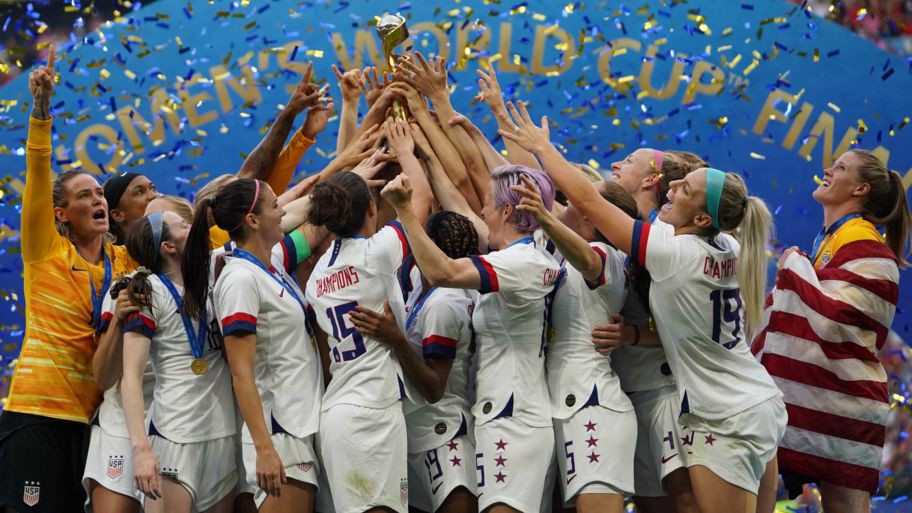Insights
Beyond the World Cup: The Play for Equal Pay.


After the final World Cup whistle blew and the U.S. women’s national soccer team scored a 2–0 victory over the Netherlands, they were met with a deafening chant: one calling for equal pay. For some spectators, the literal rallying cry for closing the salary gap between men and women athletes came as a surprise. For the players on the field below, this wasn’t a shock but the result of an ongoing legal battle.
In March, 28 professional women soccer players, including Megan Rapinoe, Alex Morgan, Carli Lloyd, and Becky Sauerbrunn, filed a lawsuit against the U.S. Soccer Federation (USSF) claiming the organization pays women players less, solely on the basis of their gender. For years, the organization has alleged that the women’s team was paid less due to “market realities” such as lower ticket sales, limited broadcast opportunities, and a lack of overall visibility of the women’s team. But with Sunday’s win, and a nation that has since exalted the players through dedicated fandom and heroes’ welcomes, does the Federation’s rationale still hold water? How will the chant — yes, the chant itself — and the subsequent media coverage tip the scales in the team’s favor? In June, the players agreed to mediation, which is set to resume shortly after the women’s team returns from France. With the U.S. women’s national team now holding the world’s title, the pressure is on.
Why It Matters
The lawsuit’s timing, coinciding as it has with the national team’s spectacular victory, has made it a magnet for media interest in today’s climate:
- In comparison to the men’s national team’s historical performance, the women’s team has now won the World Cup title four times; the men’s team has never advanced past the quarterfinal stage.
- In terms of viewership, Sunday’s game broke records as the most-watched soccer match in years on English-language TV in the United States. Globally, one in every eight people tuned in to watch.
- In the years since the U.S. women’s soccer team won the 2015 World Cup, the U.S. women’s team’s games generated more total revenue than the men’s games, according to audited financial reports from the USSF.
- Between the initial filing of the lawsuit and Sunday’s game, the issue of equal pay in World Cup or women’s national team coverage only garnered 7% of overall coverage in traditional media.
- In contrast, since the victory, the issue has commanded a whopping 22% of all coverage of the victory. Top tier outlets such as CNN, the Washington Post, ABC, the New York Times, and Fox News also took the USSF to task in examining the salary disparity between leagues after the video of the “equal pay” chant went viral. Looking at the numbers, the chant was mentioned in every article citing the equal pay issue since Sunday’s game.
- To put this all in perspective: the last time the women’s team won the World Cup back in 2015, the divide between men and women’s salaries the sport was only mentioned 29 times out of 12,000+ articles written on the event- a dismal .2% of total coverage.
- Broadening to the larger national conversation on salary disparities among genders in the workplace, between 2015 and 2019 traditional coverage increased 76% on the topic. It’d be impossible to speculate how much of an impact this past weekend will have on the issue at-large, but the topic of equal pay has stayed top of mind for media since the win, and in a 24 hour newscycle, that’s quite a feat itself.
Clyde Insights
The U.S. women’s national team unequivocally proved themselves in the 2019 World Cup, but their best players are still only paid a fraction of the average American male player in the professional league. The issues of gender equality and pay equity have seen spikes in visibility and public support in the last few years after a slew of related scandals hit newsstands, but what we haven’t seen is quick and thorough action. From a public perception standpoint, it is becoming all the more difficult to reason why the USSF is underpaying the players who they are otherwise all too happy to put on a pedestal.
In recent years, the U.S. women’s national team jerseys have outsold the men’s, women’s games have brought in more revenue than their male counterparts’, and through sheer talent and will, the women’s team’s locker room is more full with trophies and medals than the men’s down the hall. These facts and figures weren’t well known before the tournament began, but are now cited in nearly every article arguing in favor of the team’s equal pay.
For these very reasons, the pay disparity they face will likely not endure. On Sunday, the chants of spectators as FIFA President Gianni Infantino stepped onto the field made it clear that public opinion is on the side of the women’s national team. The efforts made by the media to accurately report the scene further increased public awareness of the lawsuit and the larger issue at hand. The gender wage gap, from the soccer pitch to the cubicle, is being actively pushed into the light on a larger scale than ever before. The actions of spectators, the support of viewers, and the encouragement of fans and players around the globe have all made an indelible impact on how we perceive our individual influence on the greater structure of social problem solving.
We like to think in the communications, public relations, and public affairs industry that change is most often accomplished through complex strategy, carefully crafted talking points, and deftly-managed media campaigns. But sometimes change happens more spontaneously than that. As the collective chorus heard around Sunday’s World Cup stadium reminds us, it’s important that we never underestimate the skill that has proven itself worthy throughout the ages: our voice.